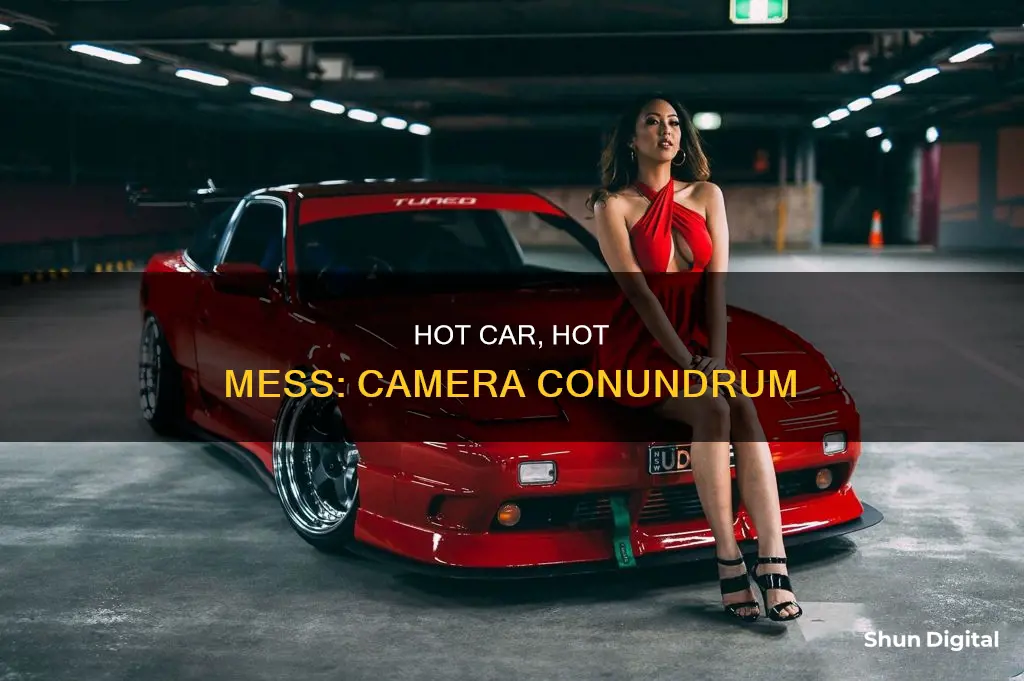
Leaving a camera in a hot car can be damaging to its internal components. The inside of a car can get exceedingly hot in the sun, with temperatures reaching 70°C and above. This can cause long-term damage to the camera's most delicate parts, including the shutter mechanism and the lens. Heat can also cause some materials in the camera to become weak and brittle. Additionally, there is a risk of theft if valuable equipment is left visible inside a car. While some photographers have reported leaving their cameras in hot cars without issue, the general consensus is that it is not a good idea.
| Characteristics | Values |
|---|---|
| Temperatures inside a car | Can exceed 120°F (49°C) |
| Effect on camera parts | Can damage delicate parts |
| Effect on camera exterior | Can cause fading and brittleness |
| Effect on film | Can cause colour cast |
| Effect on lubricants | Can cause melting |
| Effect on electronics | Can cause damage |
| Effect on plastics | Can cause breakdown |
What You'll Learn

Heat can affect delicate parts of your camera
Heat can affect some of the most delicate parts of your camera. If left in direct sunlight, long-term exposure to UV rays can cause the exterior finish to fade and some materials to become weak and brittle.
Heat can also damage electronics, and it's not good for the electrical parts of film cameras. A camera left in a hot car may experience issues with the shutter, as the heat can melt the grease used to lubricate the aperture blade assembly.
Additionally, the breakdown of plastics in modern cameras can be accelerated by high temperatures. While it may not cause immediate damage, prolonged exposure to heat can potentially affect rubber or plastic parts over time.
Reolink Camera Origins: Unveiling the Country of Manufacture
You may want to see also

Long-term exposure to UV can fade the exterior finish and weaken materials
The sun is a major source of ultraviolet (UV) radiation. While most of the UV radiation from the sun is absorbed in Earth's atmosphere, about 33% still reaches objects on the planet's surface.
Long-term exposure to UV radiation can cause physical and chemical changes to the molecular makeup of certain materials. This process, known as UV degradation, affects many natural and synthetic polymers, including some rubbers, neoprene, and polyvinyl chloride (PVC). These materials can become less flexible and develop a chalky surface over time.
The exterior finish of a camera can also be susceptible to UV degradation. Prolonged exposure to UV rays can cause the camera's exterior finish to fade and lose its original colour. Additionally, certain materials used in the construction of the camera may weaken and become brittle due to UV degradation. This can compromise the structural integrity of the camera over time.
To mitigate the effects of UV degradation, it is advisable to minimise direct exposure of cameras and other UV-sensitive equipment to sunlight. This can be achieved by storing them away from direct sunlight, using protective covers or cases, or applying UV-resistant coatings. Regular cleaning and maintenance of the camera's exterior can also help to slow down the degradation process.
Furthermore, it is worth noting that temperature extremes, humidity, and condensation can also impact the condition of cameras and other electronic devices. Therefore, it is essential to store cameras in controlled environments and allow them to adjust gradually to temperature changes.
Charging Nixon Camera Batteries: A Step-by-Step Guide
You may want to see also

Heat damages electronics
Such heat can affect some of the most delicate parts of your camera. If left in direct sunlight, long-term exposure to UV rays can also fade the exterior finish and cause some materials to become weak and brittle. Heat can also melt the grease used to lubricate the aperture blade assembly, causing oil to leak onto the blades and resulting in the aperture not stopping down properly.
In addition to the direct impact on the camera, leaving a camera in a hot car can also increase the risk of theft, as it may be visible to potential thieves.
To mitigate the effects of heat, some photographers recommend placing the camera in an insulated cooler or ice chest in the trunk of the car, which is usually cooler than the passenger compartment. Others suggest wrapping the camera in a blanket or towel to protect it from direct sunlight and help regulate the temperature. However, it is always best to avoid leaving your camera in a hot car whenever possible.
Charging Cameras Off-Grid: Keep Your Camera Always Ready
You may want to see also

Heat can melt the lubricant on the shutter
Leaving your camera in a hot car can have detrimental effects on its performance. The internal temperature of a car can exceed 160ºF/71ºC, which is far beyond the operating temperature range of most cameras. This extreme heat can cause damage to the shutter mechanism by melting the lubricant.
The shutter is a critical component in a camera, allowing the correct amount of light to reach the image sensor. A well-lubricated shutter ensures smooth and precise movements, enabling accurate control of exposure times. However, when exposed to high temperatures, the lubricant on the shutter mechanism can melt, leading to several issues.
Firstly, the loss of lubrication can cause increased friction between the moving parts of the shutter. This added friction can lead to a slower and less responsive shutter, affecting your ability to capture fast-moving subjects or achieve specific creative effects. In more severe cases, the shutter may even become stuck or difficult to operate smoothly.
Secondly, the melted lubricant can also act as an adhesive, causing the shutter blades to stick together. This can result in uneven exposure, as the light passing through the shutter may be partially blocked or obstructed by the stuck blades. This will have a detrimental effect on image quality, with potential dark bands or uneven lighting across the photograph.
Additionally, the heat can cause the lubricant to expand, potentially leaking onto other components. This could further impact the performance of the camera, as sensitive electronics and optics can be affected by the presence of excess lubricant.
To prevent these issues, it is essential to avoid leaving your camera in a hot car for extended periods. If you must keep your camera in the car, consider storing it in a well-insulated bag or container to minimise heat exposure. Alternatively, keep your camera with you or store it in a temperature-controlled environment to ensure it remains within the safe operating temperature range.
Charging Karma Grip: GoPro Power Tips
You may want to see also

Heat accelerates the breakdown of plastics
The impact of heat on plastic is not just visual. Prolonged exposure to high temperatures will cause plastic to lose strength and toughness, making it more prone to cracking, chipping, and breaking. The rate of deterioration is directly proportional to the temperature and duration of exposure. In other words, the hotter the temperature and the longer the plastic is exposed, the faster it will degrade.
This process of thermal degradation is not unique to plastic camera equipment. It is a common consideration in various industries, including medical, transportation, and industrial applications, where plastic components must be carefully selected to ensure they can withstand the operating environment.
Additionally, it is important to note that while high temperatures can accelerate the breakdown of plastics, extremely low temperatures can also have an impact on their mechanical properties. Therefore, it is crucial to store plastic items within their recommended temperature ranges to maintain their integrity and functionality.
Focusing Night Owl Cameras: Tips for Clearer Vision
You may want to see also
Frequently asked questions
The temperature inside a car can get exceedingly hot, even when it's not that warm outside. The inside of a car can reach 70°C or 160°F quite quickly.
Heat can damage the electrical parts of a camera. It can also cause the grease used to lubricate the aperture blades to melt, and accelerate the breakdown of plastics in the camera.
There are a few things you can do to protect your camera from the heat. You can:
- Put your camera in the trunk, which will stay much closer to the ambient air temperature and is also hidden from thieves.
- Put your camera in an insulated cooler or picnic bag in the trunk.
- Cover your camera with a towel or jacket to protect it from direct sunlight.







